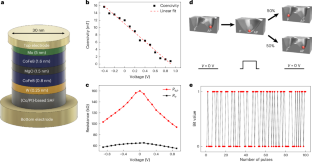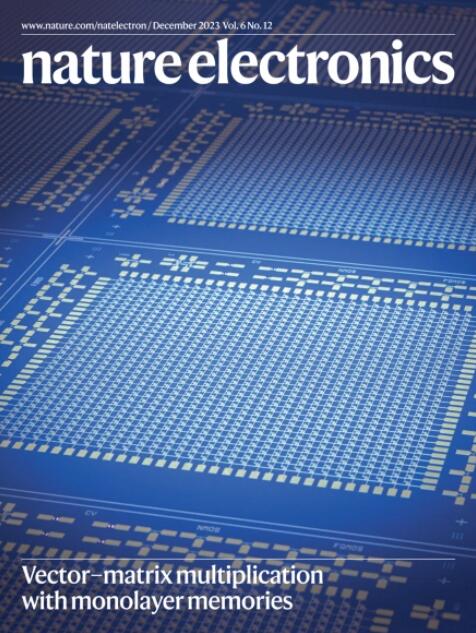An integrated-circuit-based probabilistic computer that uses voltage-controlled magnetic tunnel junctions as its entropy source
IF 40.9
1区 工程技术
Q1 ENGINEERING, ELECTRICAL & ELECTRONIC
引用次数: 0
Abstract
Probabilistic Ising machines could be used to solve computationally hard problems more efficiently than deterministic algorithms on von Neumann computers. Stochastic magnetic tunnel junctions are potential entropy sources for such Ising machines. However, scaling up stochastic magnetic tunnel junction probabilistic Ising machines requires the fine control of a small magnetic energy barrier and duplication of area-intensive digital-to-analogue converter elements across large numbers of devices. The non-spintronic components of these machines are also typically created using general-purpose processors or field-programmable gate arrays. Here we report a probabilistic computer that is based on an application-specific integrated circuit fabricated using 130-nm foundry complementary metal–oxide–semiconductor technology and uses voltage-controlled magnetic tunnel junctions as its entropy source. With the system, we implement integer factorization as a representative hard optimization problem using probabilistic Ising-machine-based invertible logic gates created with 1,143 probabilistic bits. The application-specific integrated circuit uses stochastic bit sequences read from an adjacent voltage-controlled magnetic tunnel junction chip. The magnetic tunnel junctions are thermally stable in the absence of a voltage and synchronously generate random bits without the use of digital-to-analogue converter elements using the voltage-controlled magnetic anisotropy effect. An application-specific integrated circuit that is fabricated in 130-nm foundry complementary metal–oxide–semiconductor technology, and uses stochastic bit sequences read from an adjacent voltage-controlled magnetic tunnel junction chip, can be used to solve integer factorization problems.


一种以电压控制磁隧道结为熵源的集成电路概率计算机
概率伊辛机器可以比冯·诺伊曼计算机上的确定性算法更有效地解决计算困难的问题。随机磁隧道结是这种伊辛机器的潜在熵源。然而,扩大随机磁隧道结概率Ising机器需要对一个小的磁能垒进行精细控制,并在大量设备上复制面积密集的数模转换器元件。这些机器的非自旋电子组件通常也使用通用处理器或现场可编程门阵列创建。在这里,我们报告了一种概率计算机,该计算机基于使用130纳米铸造互补金属氧化物半导体技术制造的特定应用集成电路,并使用电压控制磁隧道结作为其熵源。在该系统中,我们使用由1,143个概率比特创建的基于概率isin机的可逆逻辑门来实现整数分解作为代表性的硬优化问题。专用集成电路使用从相邻电压控制磁隧道结芯片读取的随机位序列。磁隧道结在没有电压的情况下是热稳定的,并且在不使用利用电压控制磁各向异性效应的数模转换器元件的情况下同步产生随机比特。
本文章由计算机程序翻译,如有差异,请以英文原文为准。
求助全文
约1分钟内获得全文
求助全文
来源期刊

Nature Electronics
Engineering-Electrical and Electronic Engineering
CiteScore
47.50
自引率
2.30%
发文量
159
期刊介绍:
Nature Electronics is a comprehensive journal that publishes both fundamental and applied research in the field of electronics. It encompasses a wide range of topics, including the study of new phenomena and devices, the design and construction of electronic circuits, and the practical applications of electronics. In addition, the journal explores the commercial and industrial aspects of electronics research.
The primary focus of Nature Electronics is on the development of technology and its potential impact on society. The journal incorporates the contributions of scientists, engineers, and industry professionals, offering a platform for their research findings. Moreover, Nature Electronics provides insightful commentary, thorough reviews, and analysis of the key issues that shape the field, as well as the technologies that are reshaping society.
Like all journals within the prestigious Nature brand, Nature Electronics upholds the highest standards of quality. It maintains a dedicated team of professional editors and follows a fair and rigorous peer-review process. The journal also ensures impeccable copy-editing and production, enabling swift publication. Additionally, Nature Electronics prides itself on its editorial independence, ensuring unbiased and impartial reporting.
In summary, Nature Electronics is a leading journal that publishes cutting-edge research in electronics. With its multidisciplinary approach and commitment to excellence, the journal serves as a valuable resource for scientists, engineers, and industry professionals seeking to stay at the forefront of advancements in the field.
 求助内容:
求助内容: 应助结果提醒方式:
应助结果提醒方式:


